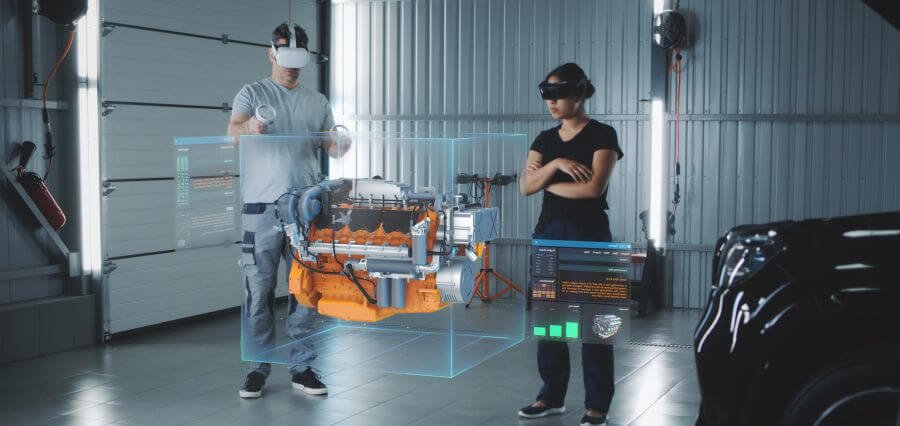From Virtual Reality to Augmented Reality
The world of education is transforming profoundly. New Immersive Learning Experiences including virtual reality (VR) and augmented reality (AR) are no longer just in a science fiction movie. These technologies are weaving into classrooms, professional training centers, and even into our homes, promising to change the way people learn, engage, and develop new skills.
From Chalkboards to Hyper-Real Simulations
For centuries, education mainly relied on passive methods, which involved sitting and listening to lectures, textbooks, and blackboards. While they are still valuable, these approaches often struggle to ignite deep engagement or cater to diverse learning preferences. But now, with immersive learning experiences enabled by VR and AR, we can learn by turning hard concepts into something we can touch and by transforming passive information intake into active exploration.
Virtual reality enables students to step into fully digital world, by cutting-off from the distraction of real-life. With a headset and hand controller, a student in Mumbai can walk in ancient Rome, dissect a digital frog, or see how a jet engine mechanics work.
Meanwhile, Augmented Reality (AR) enhances the real world by overlaying digital information. Imagine a medical student, wearing smart glasses, viewing a patient and seeing 3D visualizations of organs and procedures of the treatment is seen above the body or picture a chemistry graph that comes alive with your smartphones. AR blurs the boundary between real world and digital, making every environment a potential classroom.
Building Blocks of Immersive Learning Experiences
What makes VR and AR so good for learning? The secret lies in their ability to engage all the senses, and make us feel emotionally connected. Immersive Learning Experiences also provides opportunity for experiential learning.
- Interacting and Exploring: One can manipulate objects, experiment with things, and receive feedback right away. Making mistake does not cost anything, hence Immersive Learning experiences become encouraging and creative.
- Personalized Learning: AI algorithms can change the contents in real time according to the learners need, so you can go at your own unique speed.
- Remote Collaboration: Virtual Learning lets students and teachers from all across the globe share a single classroom. Some of the virtual tools are Google meet, Microsoft Team etc.
- Emotion and Motivation: By Immersing narratives and gamifications like adding reward points and challenges in lessons increases motivations.
Next-Generation Features Shaping the Future
Immersive Learning experiences are being shaped by fast growing technology. When VR and AR combine with tools like artificial intelligence, touch-based devices, cloud systems, and fast 5G internet, learning becomes more realistic.
Real-World Impact
Teachers are now using these new tools in bold and imaginative way to create immersive learning experiences that engage students like never before.
Medical Schools: At Stanford University, VR tools allows students to perform virtual surgery and anatomy studies, this way the students can repeatedly perform complex procedures without risk. This approach improves the confidence and also their learning skills.
Vocational Teaching: Technical colleges use mixed realty to teach automotive repair, electrical systems, and machines maintenance. Students can safely dismantle and reassemble virtual engines, wires, and circuits, which helps to get hands-on expertise.
Soft Skills Development: Companies uses VR for training in leadership, sales, and managing crises—management training placing the employee in high pressure scenarios where they need to communicate, negotiate, and collaborate.
Expanding the Horizons: Beyond the Classroom
Immersive learning experiences extends far beyond normal schooling. Museums, science center, and libraries use AR to give better learning journey. Consider a child using a tablet at a dinosaur skeleton and seeing it recreated in flesh, moving and roaring before their eyes. At home, language learning games with AR helps with better vocabulary, and adult learner who feels socially awkward can practice talking to crowds with virtual audience.
Challenges and Opportunities
High costs for development: Getting VR headsets, creating special AR/VR learning materials, and keeping everything working costs a lot of money. This makes it hard for many schools and institutions to use these technologies on a large scale.
Limited Availability: Many students and organizations cannot afford the AR/VR devices they need, leading to inequity, particularly in under-resourced communities.
Content Creation: Making engaging contents requires expertise in 3Dmodelling and programming; skills that most educational setting don’t have.
Conclusion
The next generation of immersive learning experience is not a distant dream. By mixing the power of VR and AR with AI, and cloud computing education can be more open, engaging, and effective better than ever. For educators, policymakers, and learners alike, the frontier is wide open: a world where knowledge is not just acquired, but experienced.




